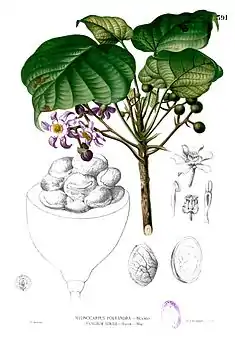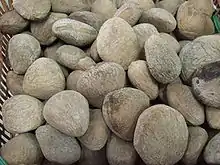Pangium edule
Pangium edule (Indonesian: keluak or keluwak; Malay: kepayang or payang;[2] Dusun: pangi[3]) is a tall tree native to the mangrove swamps of Southeast Asia (Indonesia and Papua New Guinea[4]). It produces a large poisonous fruit (the "football fruit") which can be made edible by fermentation.
| Pangium edule | |
|---|---|
 | |
| Plate from book: Flora de Filipinas | |
| Scientific classification | |
| Kingdom: | |
| (unranked): | |
| (unranked): | |
| (unranked): | |
| Order: | |
| Family: | |
| Genus: | Pangium |
| Species: | P. edule |
| Binomial name | |
| Pangium edule Reinw.[1] | |
| Nutritional value per 100 g (3.5 oz) | |
|---|---|
| Energy | 462 kJ (110 kcal) |
23.9 g | |
| Sugars | 14.1 g |
| Dietary fiber | 6.2 g |
2 g | |
2.3 g | |
| Vitamins | Quantity %DV† |
| Vitamin A equiv. | 2% 19 μg2% 230 μg |
| Vitamin C | 31% 25.8 mg |
| Minerals | Quantity %DV† |
| Calcium | 2% 15 mg |
| Iron | 17% 2.2 mg |
| Magnesium | 9% 32 mg |
| Manganese | 7% 0.155 mg |
| Phosphorus | 7% 52 mg |
| Potassium | 3% 151 mg |
| Sodium | 0% 4 mg |
| Zinc | 5% 0.43 mg |
| |
| †Percentages are roughly approximated using US recommendations for adults. Source: USDA FoodData Central | |
The taxonomy of the tree is uncertain and it may also be classed in the Flacourtiaceae[4] or the Violales.
Ecology and cultivation
The tree requires many years to mature and the seeds are therefore most frequently harvested from wild trees, as it is not economically feasible to cultivate.[5] Although poisonous to humans, the seeds of the tree form part of the natural diet of the babirusa (Babyroussa babyrussa).[6]
Culinary uses

The fresh fruit and seeds contain hydrogen cyanide and are deadly poisonous if consumed without prior preparation.[7][8][9] The seeds are first boiled and then buried in ash, banana leaves and earth for forty days,[10] during which time, they turn from a creamy white colour to dark brown or black.[11] The method relies on the fact that the hydrogen cyanide released by the boiling and fermentation is water-soluble and easily washed out.
The kernels may be ground up to form a thick black gravy called rawon, popular dishes include nasi rawon, beef stew in keluwek paste, popular in East and Central Java,[12] and sambal rawon, rawon stew made with beef or chicken also exists in East Java.[13] In West Java and Jakarta, gabus pucung or snakehead fish in pucung paste soup is a popular traditional dish in Betawi cuisine.[14] The Toraja dish pammarrasan (black spice with fish or meat, also sometimes with vegetables) uses the black keluak powder. In Singapore and Malaysia, the seeds are best known as an essential ingredient in ayam (chicken) or babi (pork) buah keluak,[15][16] a mainstay of Peranakan cuisine. Dusun tribe from Borneo use this pounded kernel as main ingredient for making local signature dish called bosou,[3] sour taste fermented fish.
People of Minahasa tribe in North Sulawesi use young leaves as vegetable. The leaves will be sliced into small part then it is cooked by mixing with herbs and pork fat or meat inside bamboo. Many sellers in Tomohon traditional market sell the leaves whether sliced or not.
Nutrition
The edible portions of the plant are an excellent source of vitamin C and high in iron.
Synonyms
- Indonesian:
- Malay:
- Kadazan:
- Pangi[2]
References
- "Sylloge Plantarum Novarum Itemque Minus Cognitarum a Praestantissimis Botanicis adhuc Viventibus Collecta et a Societate Regia Botanica Ratisbonensi Edita. Ratisbonae (Regensburg)". 2. 1825: 13. Cite journal requires
|journal=(help) - "Kluwak Pangium edule Reinw Familia: Flacourtiaceae Indonesia: Keluwek, keluwak, kluwak, kluwek, picung (Sunda), kepayang. Malaysia: Kepayang, Payang". DipoKusumo Farm Nursery. Archived from the original on 21 July 2011. Retrieved 15 October 2009.
- Lajius, Leolerry (April 2014). "Bosou - Makanan tradisi masyarakat Dusun Sabah" (PDF). Universiti Malaysia Sabah. Retrieved 23 February 2018.
- Conn B, Damas K. "Pangium edule Reinw.". National Herbarium of New South Wales, and Papua New Guinea National Herbarium. Retrieved 15 October 2009.
- Andarwulan N, Fardiaz D, Wattimena GA, Shetty K (1999). "Antioxidant activity associated with lipid and phenolic mobilization during seed germination of Pangium edule Reinw". Journal of Agricultural and Food Chemistry. 47 (8): 3158–3163. doi:10.1021/jf981287a. PMID 10552624.
- Leus K, Morgan CA, Dierenfeld ES (2001). "Nutrition". In Fischer M (ed.). Babirusa (Babyrousa babyrussa) Husbandry Manual. American Association of Zoos and Aquariums.
- Treub M (1896). "Sur la localisation, le transport, et le rôle de l'acide cyanhydrique dans le Pangium edule". Ann Jardin Bot Buitenzorg (in French). xiii: 1.
- Greshoff M (1906). Distribution of prussic acid in the vegetable kingdom. Report Brit Assn. York, England. p. 138.
- Willaman JJ (1917). "The estimation of hydrocyanic acid and the probable form in which it occurs in Sorghum vulgare". J Biol Chem. 29 (1): 25–36.
- Chia CC. "Buah Keluak". Archived from the original on 30 June 2012. Retrieved 15 October 2009.
- Wong WH (11 January 2007). "Buah Keluak". National Parks.
- Nyonya Rumah (24 July 2012). "Nasi Rawon Komplet" (in Indonesian). kompas.com. Retrieved 24 July 2013.
- "Tarry, Tarry Night". 22 May 2007. Retrieved 15 October 2009.
- Media, Kompas Cyber. "Jakarta Ulang Tahun, Yuk Coba 5 Kuliner Betawi Langka Ini Halaman all". KOMPAS.com (in Indonesian). Retrieved 1 July 2020.
- Ng L (29 October 2007). "Ayam/Pork Buah Keluak".
- Chia CC. "Ayam/Babi Buah Keluak". Archived from the original on 30 June 2012. Retrieved 15 October 2009.
- "Kloewak [Pangium edule]". Objectief. Archived from the original on 12 November 2009. Retrieved 15 October 2009.